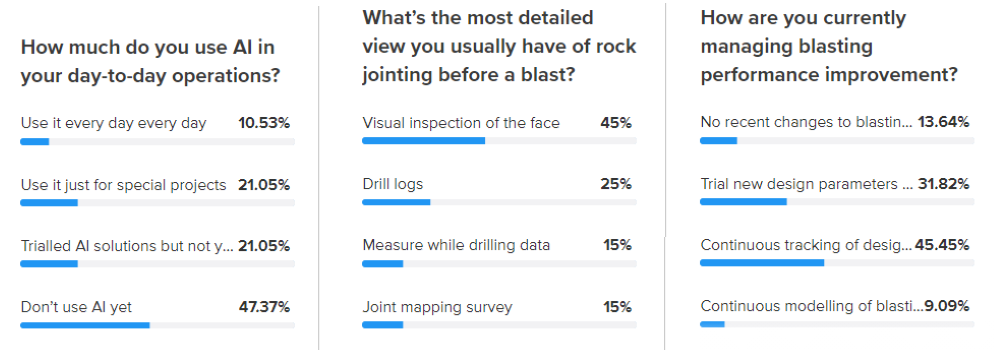Webinar Summary- Strayos Under the Hood: The Engine Driving the Mine to Mill AI
Mining is the perfect industry to leverage the power of AI. It produces mountains of data everyday from site operations and can realize significant value from using AI. However, implementing AI can be intimidating. Many people still view it as a “black box”. So, to help, Strayos is pulling back the curtain and sharing with you how the AI magic is made.
Join Strayos experts Ravi Sahu & Brad Gyngell as they discusses how AI can help realize some of the biggest opportunities in the drilling, blasting, and mining industries, and how it can help mines achieve a more sustainable future.
Learn:
- How to prepare data for a successful AI pipeline
- What it takes to develop an accurate industrial grade AI model
- Dig Deeper AI Applied: Rock Mass Characterization, Fragmentation, & Pit Optimization
- How the AI feedback loop unlocks hidden insights
- Using AI-powered Scenario Analysis to better plan the future
- How to 10x your mine's output using AI in your workflow
Materials
If you would rather watch the webinar click here.
To download a copy of the Presentation slides click here.
Q&A
We'll start at the end...
Unfortunately we ran out of time before we were able to answer everyone's questions. So, as promised, here are the answer to the questions asked during the webinar...
1. What is the accuracy of fragmentation prediction from whole blasted muck pile?
The accuracy of the fragmentation prediction on a blast muck pile depends upon few different factors:
- Accuracy in data and imagery collection - The better the pixel resolution the more accurate the edge detection results. Our best practices guidelines describes some of the ways to improve data collection.
- Data analysis and AI detection: AI detection for rock sizes utilizes pixel based segmentation and it has been compared and verified with ground truth data such as manual scale measurements and placing golf balls in blasted muckpile.
2. How the joints extends inside the rock mass is confirmed, many times bench faces are not cleaned or filled with dirt's?
With visual RGB photo data such as drone 3D model several key bench features using RockMass AI can be detected such as Joints, bedding blane, strike and orientation.
In order to see the bench faces which are filled with dirts - different type of sensing solutions can be used such as Lidar and Hyperspectral sensors.
3. Can this data be integrated into MineStar or Modular gravity calculations to help with reporting accuracy?
Yes, Strayos generates variety of industry standard file format and it can be exported to 3rd party applications including Minestar.
4. From your experience what % of boulder material can be allowed for secondary breakage before considering for redesigning of blast design parameters, for optimization
The % of boulder material is subjective to the type of operations and plant processing setup. In order to consider any blast optimization KPIs. Whole upstream and downstream workflow needs to be understood to make any design parameter changes.
5. Is there a risk that AI could make humans less intelligent or get used by people that would not have the common sense to know the answer from AI may be wrong? I think of an exercise years ago where my students were going of there tablet GPS and I had to say I do not care what the tablet GPS says. The sun rises in the east and set in the west and you are heading in the wrong direction. This does not mean I do not believe in AI as being good but what type of safe guards are needed or can we use? I like to use a statistical method called the null hypothesis before I accept the answer.
We believe AI is just a decision making tool with speed and scale. It empowers human to run what if scenarios and consider all the parameters to ensure the associated impact from that decision. The future we believe is where Artificial Intelligence(AI) will absorb mundane tasks and as a result human intelligence (HI) could thrive with their talent on innovation and creativity.
6. How can your models used to ensure grade variability is minimal?
Our hyperspectral sensor AI models can be applied to detect grade variability across the site, the rock bench or the muckpile. This can be used to minimize the grade variability entering the processing plant by enabling selective mining operations in the planning, blasting and loading phases.
7. How do you incorporate the right explosive consumption in the AI system to help in blast? What about the grade variability prediction?
The incorporation of right amount of explosives is subjected to several variables such design pattern, geology, rock mass, desired fragmentation, equipment's used in operations and crusher throughput requirements etc. Al can consider all the variables and further calibrate to specific site to arrive at right amount of explosive consumption.
Poll Questions

Speakers
Ravi Sahu CEO | Strayos

Ravi Sahu is a Founder and CEO of Strayos. Before founding Strayos, he spent more than 12 years working globally with Fortune 500 companies like AT&T, Verizon and British Telecom in various roles, from product management to the building teams for large digital transformation projects. His area of expertise is in computer vision, machine sensor data analytics and artificial intelligence. He holds an MBA from Washington University in St. Louis and a computer science engineering degree from India.
Brad Gyngell COO | Strayos

Brad helps mining companies maximize the value of their operations. He spent the first phase of his career helping over 100 sites optimize drill and blast activities as a mining engineer with the world's leading explosives providers Orica and Dyno Nobel.
He then expanded the scope of his support to encompass all commercial and operational functions by moving into management consulting with the top tier firm Boston Consulting Group. As COO of Strayos, Brad leads the development of AI solutions that combine visual and operational data sources to solve tangible use cases for mine operators.
Brad holds a B Eng (Mining Engineering) from UNSW and an MBA (Finance, Entrepreneurship) from Carnegie Mellon University.

New technologies are rapidly changing the drilling, blasting, mining, and aggregates industries, empowering them in ways never before possible. Make sure you are taking advantage of the best tools available.
Check out our 2 Free E-books on AI applications for the drilling, blasting, and mining industries to see all the amazing advances that are available.
AI Guide for Drilling and Blasting
AI Guide for Mining
TLDR? Watch our videos instead:
YouTube
